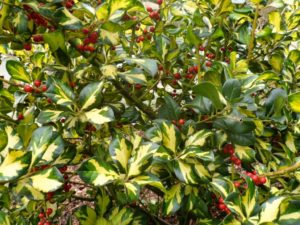 For December, we would like to highlight a plant associated with the winter holidays: Ilex aquifolium myrtifloia ‘Aurea Maculata’ — or, as most of us know it, English Holly ‘Myrtifolia Aurea Maculata.’
For December, we would like to highlight a plant associated with the winter holidays: Ilex aquifolium myrtifloia ‘Aurea Maculata’ — or, as most of us know it, English Holly ‘Myrtifolia Aurea Maculata.’
Don’t worry — this sophisticated holly variety is only a distant relative of the unruly, and often dreaded, Common English Holly that still lurks in some old city gardens.
The glossy, grass green leaves of English Holly ‘Myrtifolia Aurea Maculata’ typically have a bright golden yellow irregular center. They curl both upward and downward, reflecting light and giving the leaves an interesting texture. With bright red berries that ripen in autumn, English Holly ‘Myrtifolia Aurea Maculata’ becomes a beacon in your winter garden. Hint: You can use an accent light to show case this attractive foliage at night. No strings of lights required!
Depending on where you plant it and how you prune it, English Holly ‘Myrtifolia Aurea Maculata’ can be a uniformly compact bush or large shrub. You don’t want to sheer this plant, but regular pruning and thinning will help maintain its size and ensure that it produces new berry-laden branchlettes each season. It’s easy to work with — this hybrid variety was cultivated to eliminate the sharp, prickly leaves synonymous with the rest of the Genus. Hint: If you enjoy a traditional holiday decorations, prune this holly before the holidays and use the clippings as you create arrangements for the front porch or mantel.
English Holly ‘Myrtifolia Aurea Maculata’ is not only a perfect shrub for wintertime but an attractive landscape plant all year round. Because it has no “down time,” it’s an excellent accent or anchor plant in ornamental landscapes.
It grows well in average garden conditions, but absolutely thrives in poor soil and hot dry conditions — all it needs is some pruning to maintain its desired size. If you want it to produce lots of fall berries, make sure to plant it where it gets plenty of sun.
December is still a good time to purchase broad-leaf evergreens like English Holly ‘Myrtifolia Aurea Maculata’ and conifers and get them into the ground. You can make this attractive plant part of your holiday outdoor decorating.
To learn more about garden planning, landscape design, and easy plants for your garden, please contact us.
